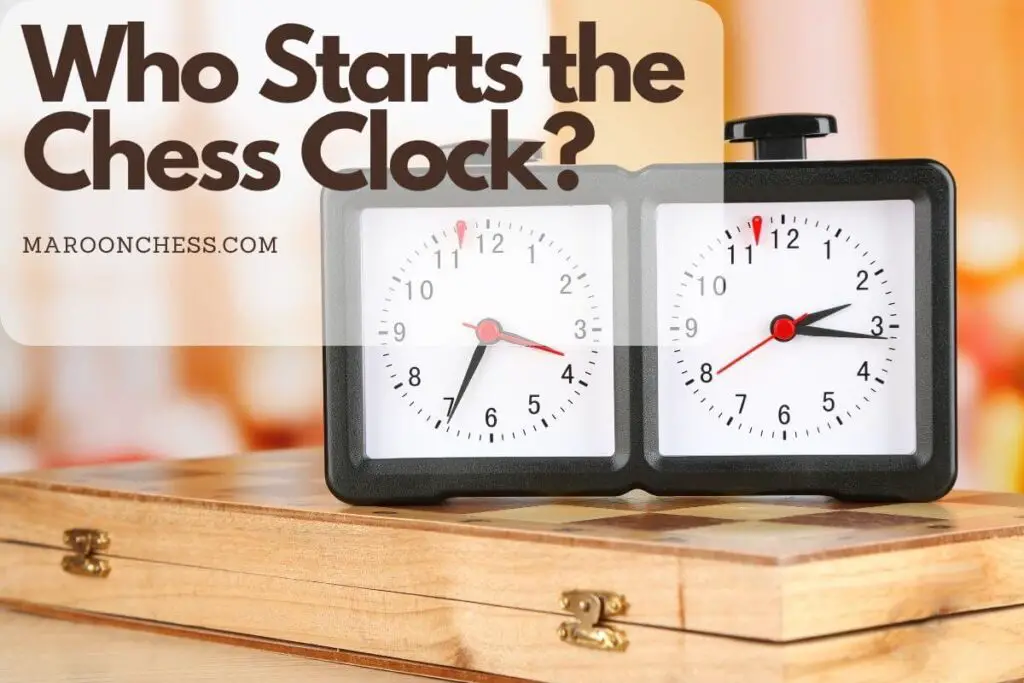If you’ve ever played chess before, then you know that it’s so much more than moving pieces around. Many rules are set to guarantee everyone has a fair chance, including a few ones about using the chess clock. But have you ever wondered who starts the clock in chess?
Yes, there’s a rule for that too, and it makes complete sense. We all know that white, or the lighter color, makes the first move. For that reason, black, or the darker color, is the one to start the clock. Once black taps their button, their opponent’s clock starts ticking, and the game begins!
That’s not the only privilege that black/dark has when it comes to the clock. There’s more!
What Are Other Perks of Playing With Black?
Starting the clock isn’t the only privilege of playing with the darker pieces. Black/dark also gets to decide on which side of the board the clock goes.
Most players prefer to have it to their right, making it closer to their dominant hand.
But if the player with black/dark pieces decides to have it on their left, then that’s where it’ll be. Since players must tap their clock buttons with the same hand they play with, this rule gives black a competitive edge over their opponents.
For example, if both players have their right hand as their dominant hand, black can use this to their advantage. They could put it away from their opponent’s dominant hand to maximize the time they take to reach the button.
However, there’s an exception to the clock placement rule. If the event was rated by the International Chess Federation FIDE, then the arbiter is the one who decides where to place the chess clock.
But what is a chess clock, really? How’s it different from any other regular clock? And is there anything else players need to know about chess clocks?
Chess clocks are a crucial factor in every professional chess game. For that reason, every chess player needs to know at least the basics about these clocks. So let’s get you up to speed with a quick crash course.
What Is a Chess Clock?
One chess clock consists of two adjacent clocks that calculate the time separately for each player during their turn. Only one clock can work at a time, so players alternate clocks between turns by pressing a button after each move.
At the beginning of a game, both players agree on the time of the game and set up their clocks. After making their move, the player presses the button on the clock to stop theirs and start their opponent’s.
Throughout the game, the clock will show each player how much time they have left till the end of the game. Usually, chess clocks will have a tiny flag marking the end of the game. If a player’s flag falls, then their time’s up.
Players lose the game if they run out of time—even if they were so close to checkmating. They lose if they haven’t verbally announced their victory before they run out of time.
Why Is It Important?
In professional chess tournaments, time is a crucial element. These tournaments get divided into 5, 6, or 9 rounds. Each round is divided into time segments. The first round is 60 minutes for each player. Then, the following rounds could be 30 minutes or less.
The only way to apply this schedule is by using chess clocks for every game. Otherwise, chess games won’t be controlled. Tournaments would take much longer than they should.
Another reason a chess clock is crucial is to restrict the player’s strategy. When players are limited by time, they’ll plan their move much faster. This limitation makes the game more about quickly spotting patterns instead of overthinking strategies.
If chess games weren’t time-restricted, players would waste time planning their next move or looking for an impressive checkmate. They’ll focus less on winning and more on looking good.
What Are the Types of Chess Clocks?
Chess clocks come in two main types: analog and digital. Analog clocks are the classic two-hand type. It uses a minute hand and a second hand to show how much time has passed since the beginning of the game.
Digital clocks, on the other hand, are the modern take on chess clocks. They display the exact time left using digital numbers on a screen. This feature makes digital clocks much more accurate and reliable.
They also have unique features, such as calculating time increments, time delays, and adding bonus time after 40 moves.
Who Decides the Clock Type?
The answer to this question depends on the event. If it’s a USCF tournament, then you could find classic analog clocks. But if there are time increments or time delays, then you’ll use a digital clock. That’s because digital clocks support the time setting required for the tournament.
Meanwhile, you’ll find a digital chess clock if it’s a FIDE-rated event. If it’s not a professional tournament, then the option goes back to the players. If both players have their own clocks, then the digital one is preferred.
Having both players agree on the type of clock is another solution for choosing the right one for the game.
What Are the Different Time Controls?
In live chess, there are three different ratings of time controls:
- Bullet Rating: which is for any game under 3 minutes.
- Blitz Rating: for games that are between 3 to 24 minutes.
- Standard Timing: reserved for any game that takes 15 minutes or more.
To Wrap Up
As a rule of thumb, every rule or regulation in chess is set to ensure a fair game. This includes dividing the privileges between black and white. Black gets to start the clock, and in most cases, choose its position. On the other hand, white gets to make the first move.
So, to do your best as a chess player, make sure you know all the regulations of professional chess by heart.


